Tribunal Statistics Quarterly, July to September 2021
Published 9 December 2021
1. Main Points
This publication presents tribunals statistics for the latest quarter (July to September 2021, Q2 2021/22), compared to the same quarter the previous year. As different tribunals were affected in different ways due to measures required to deal with the pandemic, additional comparisons to the first quarter of 2019/20 – pre-pandemic - have also been provided.
This publication does not include receipts, disposal and caseload outstanding figures for the Upper Tribunal Immigration and Asylum Chamber (UTIAC), Employment Tribunal (ET) or Employment Appeal Tribunal (EAT) due to these tribunals being migrated to new case management systems. The data will be made available as soon as possible, and once the data is quality assured. The total of the remaining jurisdictions is referred to in this publication and accompanying tables as the ‘Interim Total’ and has been provided to allow year-on-year comparisons over time.
| The interim[footnote 1] overall volume of receipts have increased, and disposals and caseload outstanding have decreased | Her Majesty’s Courts & Tribunals Service (HMCTS) recorded an increase of 4% in the interim[footnote 1] totals for receipts in July to September 2021 compared to the previous year, driven mostly by the First-tier Tribunal Immigration and Asylum Chamber (FTTIAC) and First-tier tax chamber. Disposals and caseload outstanding interim[footnote 1] totals decreased by 11% and 16% respectively. However, compared to the same quarter in 2019/20 (pre-pandemic), the interim[footnote 1] totals have decreased by 22%, 41% and 28% respectively. |
| SSCS receipts, disposals and caseload outstanding all decreased | Social Security and Child Support (SSCS) receipts, disposals and caseload outstanding decreased (by 31%, 37% and 52% respectively). A 46% fall in Personal Independence Payment (PIP) drove the fall in receipts. The decrease in disposals was driven mostly by a 52% and 39% fall in Universal Credit (UC) and PIP respectively. Compared to 2019, SSCS totals decreased by 46%, 54% and 66% respectively. |
| FTTIAC receipts, disposals and caseload outstanding all increased | FTTIAC receipts, disposals and caseload outstanding rose (by 82%, 219% and 50% respectively) compared to the same period in 2020. However, compared to 2019 (pre-pandemic), these totals decreased by 8%, 30% and increased by 63% respectively. |
| SEN appeals and disposals up 8% and 12% respectively | In the academic year 2020/21, HMCTS tribunals recorded 8,600 registered appeals in relation to SEN, an increase of 8% when compared to the prior year. In the same period, 7,600 SEN appeals were disposed of, an increase of 12% on 2019/20. |
For feedback related to the content of this publication, please contact us at CAJS@justice.gov.uk
2. Statistician’s Comment
This quarter’s publication does not include receipts, disposals and caseload outstanding figures for the Upper Tribunal (Immigration and Asylum Chamber), Employment Tribunal (ET) or Employment Appeal Tribunal (EAT) due to migrating these tribunals to new case management systems. The data will be made available once the management information has been quality assured.
As policies which were put in place due to COVID-19 come to an end and restrictions are eased, we begin to see a rise in demand and a return to pre-COVID19 levels of receipts of some Tribunals.
SSCS data shows volumes of disposals, receipts and outstanding cases have continued their downward trend and are still far below 2019’s pre-COVID19 baseline. Total receipts are 46% lower while disposals and outstanding caseload are at 54% and 66% respectively. A 46% fall in Personal Independence Payment (PIP) drove the drop in receipts, while a 52% and 39% decrease in Universal Credit (UC) and PIP respectively were responsible for the decline in disposals.
Following on from a steep fall in 2020/21 due to the impact of the pandemic, First-tier Tribunal Immigration and Asylum Chamber figures rose to pre-pandemic levels across all activities. Part of the increase can be attributed to the closure of the main EU Settlement Scheme (EUSS) route on 30 June 2021. This led to an increase in EEA/EUSS appeals and represented 44% of all FTTIAC receipts. Human Rights receipts which represent 37% of all FTTIAC receipts also increased while Asylum/Protection at 18% of all receipts, fell by 5% compared to the same period in 2020.
There was an increase of 8% to 8,600 in SEN registered appeals in the last academic year. This is highest recorded in any academic year. The Gender Recognition Panel also received the highest number of applications in any one quarter since 2009.
3. Overview of Tribunals
Receipts interim[footnote 1] total was 52,000 and disposals interim[footnote 1] total was 50,000
In July to September 2021, HMCTS recorded a 4% increase and 11% decrease in the interim[footnote 1] totals for receipts and disposals respectively, when compared to the same quarter in 2020. Caseload outstanding interim[footnote 1] total decreased to 116,000, down 16%, over the same period.
This publication does not include Upper Tribunal (Immigration and Asylum Chamber), Employment Tribunal (ET) and Employment Appeal Tribunal (EAT) data for the reason stated above. The total of the remaining jurisdictions is referred to in this publication and accompanying tables as the ‘Interim Total’ and has been provided to allow year-on-year comparisons over time. On average over the last 5 financial years, the interim total makes up 72% of receipts, 86% of disposals and 31% of caseload outstanding.
This summary bulletin focuses mainly on the Social Security and Child Support (SSCS) tribunal and the First-tier Tribunal Immigration and Asylum Chamber (FTTIAC) as they made up the majority (56%) of tribunal interim[footnote 1] receipts in July to September 2021:
-
Social Security and Child Support (SSCS) – 37% of the interim[footnote 1] receipts total
-
First-tier Tribunal Immigration and Asylum Chamber (FTTIAC) – 19% of the interim[footnote 1] receipts total
Figure 3.1: Receipts interim totals, Q2 2017/18 to Q2 2021/22 (Source: Tables S_2)
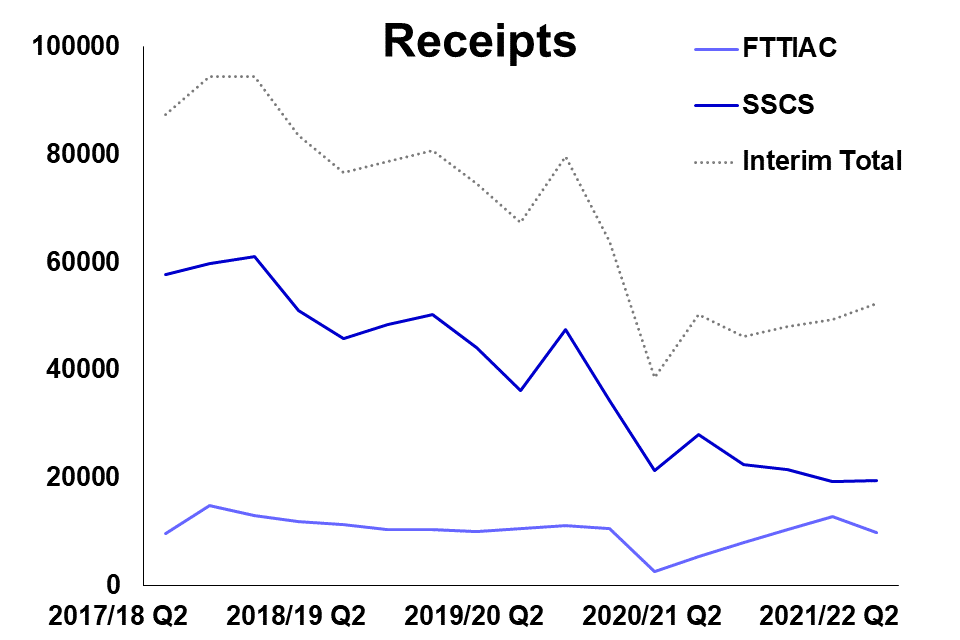
Figure 3.2: Disposals interim totals, Q2 2017/18 to Q2 2021/22 (Source: Tables S_3)
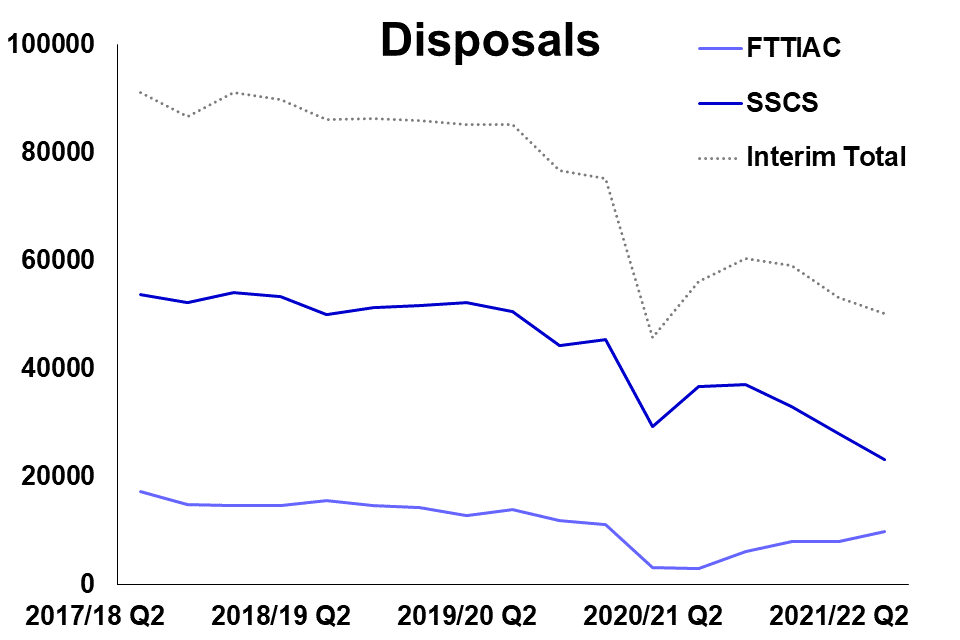
Figure 3.3: Caseload outstanding[footnote 2] interim totals, Q2 2017/18 to Q2 2021/22 (Source: Tables S_4)
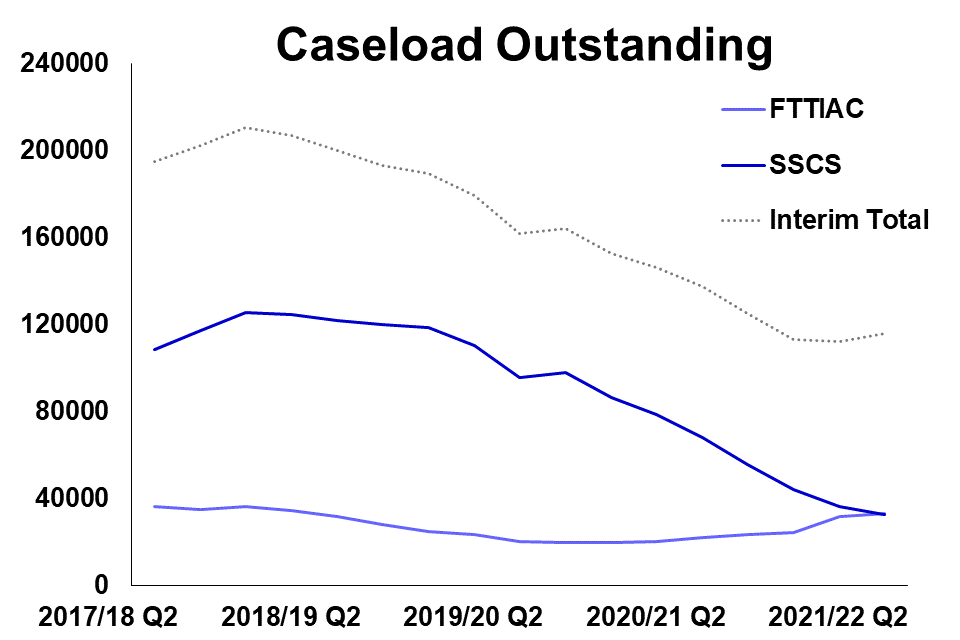
The charts above show the trends in receipts, disposals and caseload outstanding over the last five years for SSCS, FTTIAC and all tribunals overall (using the Interim Total measure). In July to September 2021, receipts increased by 4% compared to July to September 2020. This was driven by increases in FTTIAC and First-tier tax chamber, of 82% and 314%, to 9,800 and 6,400 receipts respectively. This rise is largely due to case levels returning to normal following the impact of the COVID-19 pandemic and related government actions to mitigate the effects on society in the previous financial year.
Disposals decreased by 11% in July to September 2021 (50,000), compared to July to September 2020. Compared to Q2 2019/20, which was pre-COVID, the volume decreased by 41%. The FTTIAC disposed of 219% more cases in Q2 2021/22 compared to Q2 2020/21. The rise was offset by a 37% decrease in SSCS disposals. Compared to the same quarter in 2019, FTTIAC disposals decreased by 30%.
There were 116,000 cases outstanding at the end of September 2021, down 16% compared to a year ago. The 50% increase in FTTIAC, was offset by a 52% decrease in SSCS caseload outstanding.
4. Social Security and Child Support
SSCS receipts, disposals and caseload outstanding all decreased
SSCS receipts, disposals and caseload outstanding have all decreased when compared to July to September 2020, by 31%, 37% and 52% respectively.
63% of disposals were cleared at hearing with a 59% overturn rate
Of the 23,000 disposals in July to September 2021, 63% were cleared at a hearing and of these, 59% had the initial decision revised in favour of the claimant (down from 69% and 72% in the same period in 2020 respectively).
Figure 4.1: Social Security and Child Support receipts, Q2 2019/20 to Q2 2021/22 (Source: Tables SSCS_1)
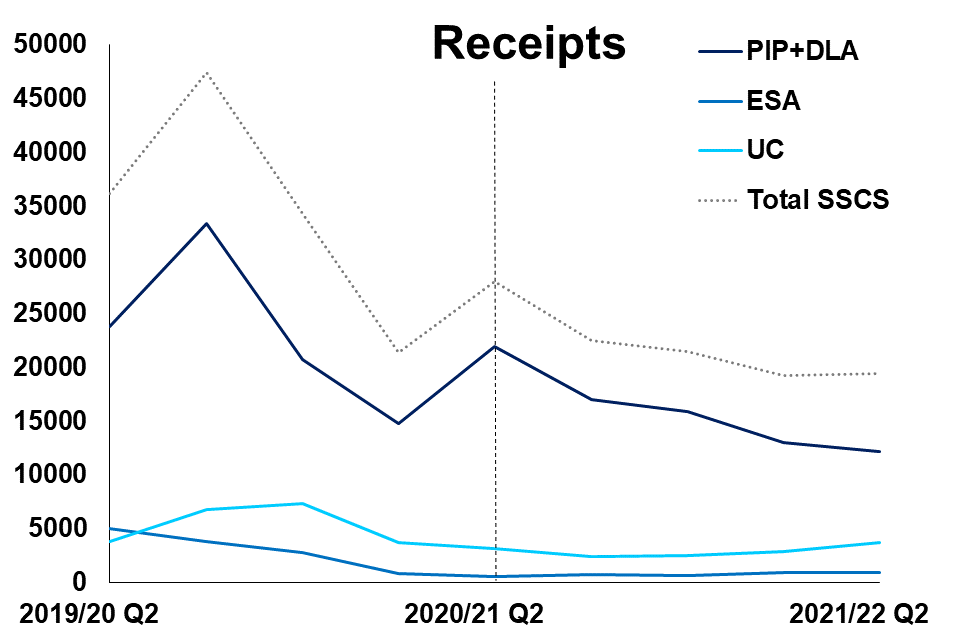
Figure 4.2: Social Security and Child Support disposals, Q2 2019/20 to Q2 2021/22 (Source: Tables SSCS_2)
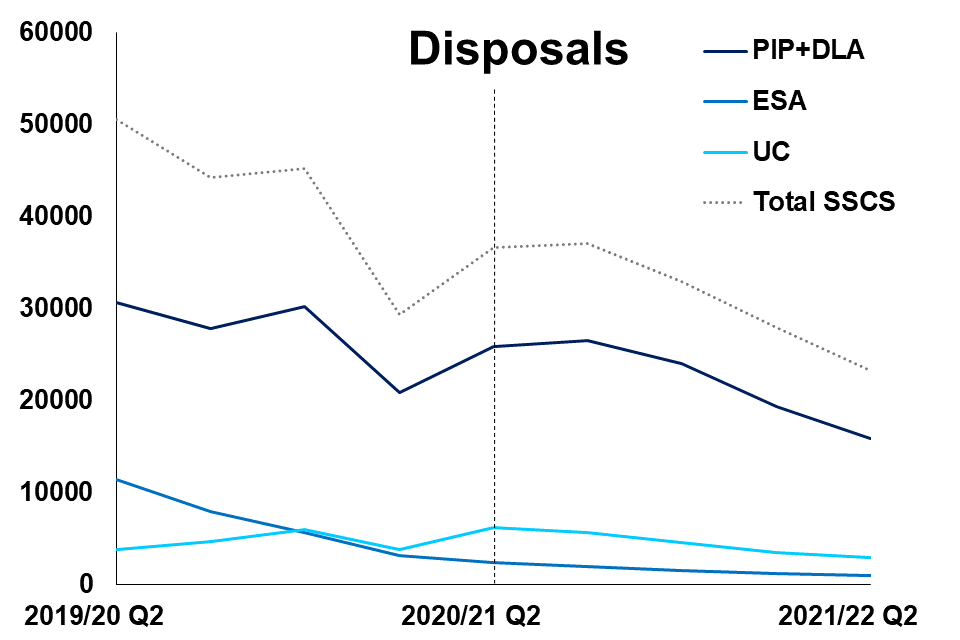
Figure 4.3: Social Security and Child Support caseload outstanding, Q2 2019/20 to Q2 2021/22 (Source: Tables S_4)
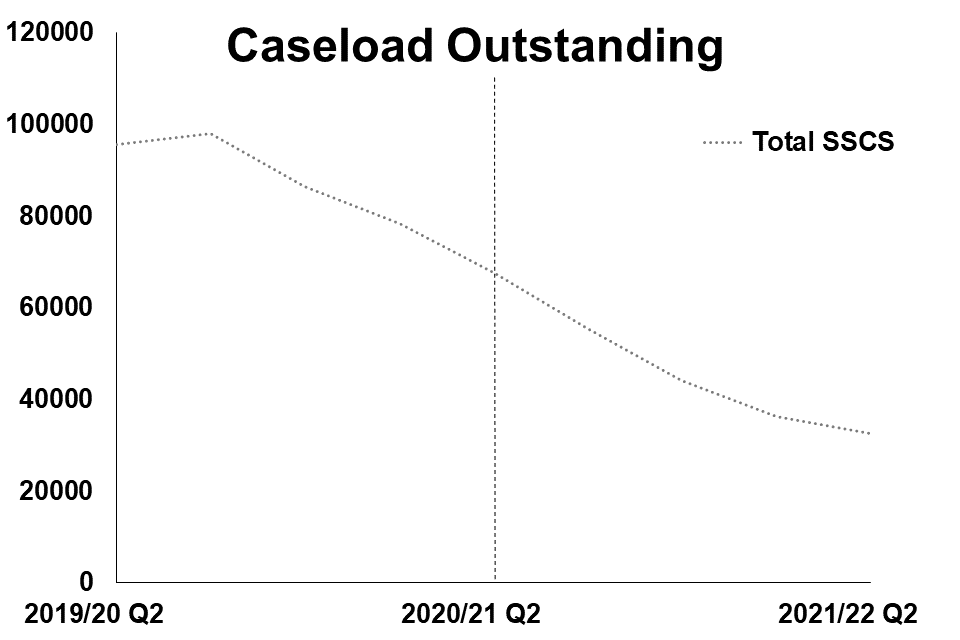
The economic impact of the COVID-19 pandemic resulted in an increase in the number of people on Universal Credit.[footnote 3] The Department for Work and Pensions (DWP) changes to benefit processes in response to the pandemic, such as the temporary suspension of face-to-face assessments for health and disability-related benefits, has contributed to a fall in SSCS tribunal receipts.
SSCS tribunal receipts decreased by 31% this quarter, to 19,000 appeals, compared to July to September 2020. This was driven by a 46% fall in Personal Independence Payments (PIP). PIP appeals accounted for 57% of all SSCS receipts in July to September 2021.
PIP also made up nearly two thirds of SSCS disposals (62%). In July to September 2021, there were 23,000 SSCS cases disposed of, a fall of 37% when compared with the same period in 2020. SSCS disposals decreased between Q3 2020/21 and Q2 2021/22, from 37,000 to 23,000.
Of the disposals made by the SSCS Tribunal, 15,000 (63%) were cleared at hearing, and of these, 59% were overturned in favour of the customer (down from 69% and 72% on the same period in 2020 respectively). This overturn rate varied by benefit type, with PIP at 67%, Disability Living Allowance (DLA) 65%, Employment Support Allowance (ESA) 54%, and UC 42%. The PIP, DLA, ESA and UC overturn rates fell by 9, 5, 22 and 21 percentage points on July to September 2020 respectively.
There were 33,000 SSCS cases outstanding at the end of September 2021, down 52% compared to the same period in 2020. This continues the fall that began in Q4 2018/19 (when comparing to the same quarter in the previous year). Since Q4 2017/18, caseload outstanding has been gradually decreasing (from a peak of 125,000), only rising in Q3 2019/20, reversing the consistent rising trend seen since Q4 2015/16.
Of those cases disposed of by the SSCS tribunal in July to September 2021, the mean age of a case at disposal was 39 weeks, five weeks more than for the same period in 2020 (see tables T_2) and nine weeks more than the same period in 2019.
5. Immigration and Asylum
First-tier Tribunal Immigration and Asylum Chamber (FTTIAC)
In July to September 2021, FTTIAC receipts and disposals increased, by 82% and 219% (both to 9,800), compared to the same period in 2020.
In the same period, caseload outstanding also increased by 50% (to 33,000).
Figure 5.1: First-tier Tribunal Immigration and Asylum Chamber receipts, Q2 2019/20 to Q2 2021/22 (Source: Tables FIA_1)
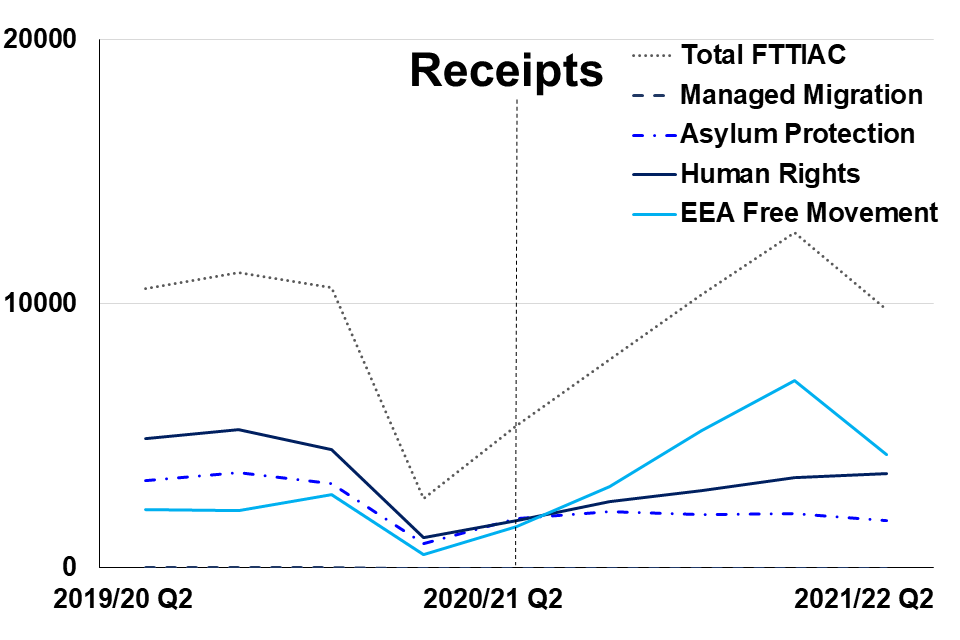
Figure 5.2: First-tier Tribunal Immigration and Asylum Chamber disposals, Q2 2019/20 to Q2 2021/22 (Source: Tables FIA_2)

Figure 5.3: First-tier Tribunal Immigration and Asylum Chamber caseload outstanding, Q2 2019/20 to Q2 2021/22 (Source: Tables S_4)

The main EU Settlement Scheme (EUSS) route closed on 30 June 2021. In July to September 2021, EEA/EUSS receipts proportionally represented 44% of all FTTIAC receipts (up from 29% a year ago). In Q2 2021/22 there was a 175% and 101% increase in EEA/EUSS and Human Rights (HR) receipts respectively (to 4,300 and 3,600 respectively), compared to the same period in 2020. Asylum/Protection (AP) receipts decreased by 5% compared to the same period in 2020 (to 1,800). HR and AP proportionally represented 37% and 18% of all FTTIAC receipts respectively (up 3 and down 17 percentage points respectively from a year ago).
Following on from a steep fall in 2020/21 due to the impact of the pandemic, this quarter there was a rise in FTTIAC receipts to 9,800 returning to pre-covid levels. The rise was due to an increase in EEA/EUSS and Human Rights appeals.
The FTTIAC disposed of 9,800 appeals in July to September 2021, a 219% increase on the same period in 2020. The Home Office has increased decision making activity as travel restrictions are lifted and visa centres in the UK and abroad resume normal service. This rise in disposals was driven by a 132%, 104% and 610% rise in HR, AP and EEA disposals respectively. EEA appeals made up the largest proportion (43%) of all FTTIAC disposals in July to September 2021, up from 19% a year ago.
Of the disposals made in the FTTIAC this quarter, 57% were determined i.e. a decision was made by a judge at a hearing or on the papers (compared to 80% in Q2 2019/20 and 39% in Q2 2020/21); 14% were withdrawn (compared to 16% in Q2 2019/20 and 38% in Q2 2020/21); 8% were struck out for non-payment of the appeal fee (compared to 2% in Q2 2019/20 and 3% in Q2 2020/21), and 2% were invalid or out of time (compared to 2% in Q2 2019/20 and 3% in Q2 2020/21). Just over half (52%) of the 5,600 cases determined at a hearing or on the papers were allowed/granted, although this varied by case type (48% of Asylum/Protection, 58% of Human Rights and 48% of EEA Free Movement appeals were allowed/granted).
The First-tier Tribunal Immigration and Asylum Chamber received 94 Deprivation of Citizenship receipts, an increase of 109% compared to the same quarter last year, and an increase of 224% compared to the same quarter in 2019/20 (pre-covid). Deprivation of Citizenship disposals increased by 508% compared to the same quarter last year and by 126% compared to the same quarter in 2019/20.
In the FTTIAC, the mean time taken to clear appeals across all categories is at 39 weeks this quarter, which has not changed compared to the same period a year ago. Asylum/Protection, Human Rights and EEA Free Movement had mean times taken of 48 weeks, 45 weeks and 29 weeks respectively.
UTIAC Immigration and Asylum Judicial Reviews
In July to September 2021, there were 570 Immigration and Asylum Judicial Review receipts and 480 disposals, up 51% and down 50% respectively on July to September 2020.
Of the 480 Immigration and Asylum Judicial Reviews disposed of, 54% were determined and 2% were transferred to the Administrative Court. The remaining 44% were in the ‘Other’ category, which includes cases that were withdrawn or not served.
During July to September 2021, 350 UTIAC Judicial Review applications were determined by paper hearing, of which 12% were allowed to continue to the substantive hearing stage. A further 110 were reconsidered at an oral renewal, of which 30% were allowed to continue to the substantive hearing stage. There were 12 substantive hearings which were determined in July to September 2021, of which 33% were granted in favour of the appellant (see table UIA_3).
6. Gender Recognition Certificates
222 Gender Recognition Panel (GRP) applications were received and 112 were disposed of between July to September 2021; 352 applications were pending by the end of September 2021
GRP applications received this quarter rose to 222, an increase of 73 compared to July to September 2020. This is the highest number seen in any one quarter since 2009. Of the 112 applications disposed of, a full Gender Recognition Certificate (GRC) was granted in 94% of cases (105 full GRCs), one percentage point lower than in the same period in 2020 (where 68 full GRCs were granted out of 72 disposals).
GRP receipts have increased annually since 2017/18 and we expect this trend to continue following a reduction in the application fee in May 2021 from £140 to £5, and the move to an online application process. This has subsequently caused an increase in caseload outstanding, reaching a high of 352 cases in Q2 2021/22.
Since April 2005/06, when the Gender Recognition Act 2004 came into effect, 71% of interim certificates (170 of the 238 interim GRCs granted) have been converted to a full GRC, 52% of which were converted within 30 weeks. No interim certificates were converted to a full GRC between July to September 2021.
Of the 105 full certificates granted in July to September 2021, 11 were for married applicants and 94 for single applicants. 59 (56%) of the individuals granted full certificates were registered male at birth while 46 (44%) were registered female at birth.
Figure 6.1: Applications for Gender Recognition Certificates received, disposed of and pending, 2010/11 to 2020/21 (Source: Tables GRP_1 and GRP_2)

Figure 6.2: Full Gender Recognition Certificates granted by year of birth, 2010/11 to 2020/21 (Source: Table GRP_4)
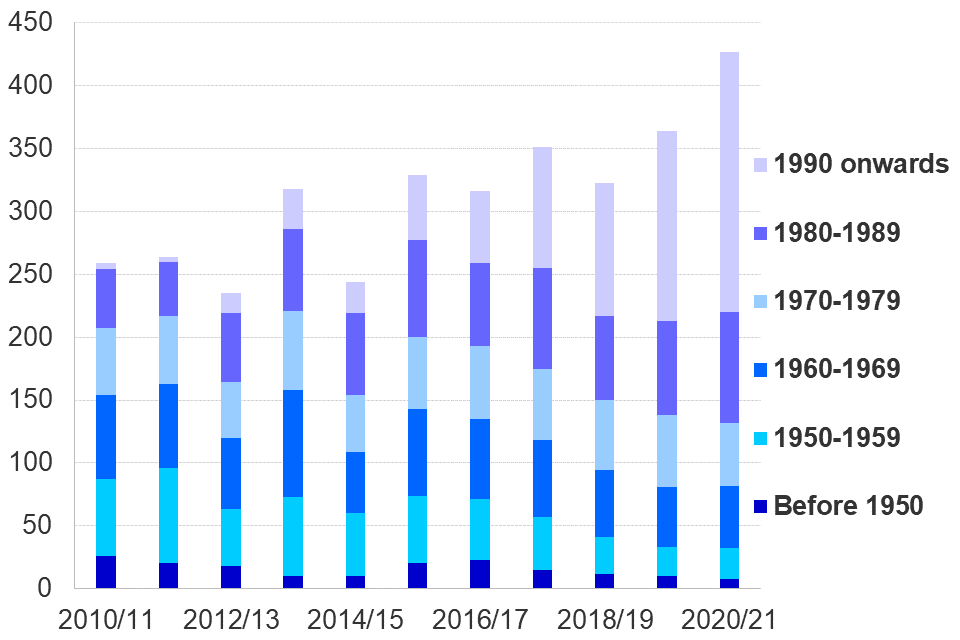
7. Special Educational Needs and Disability (SEND)
Increase in registered SEN appeals, up 8% when compared to 2019/20
In the academic year 2020/21, HMCTS tribunals recorded 8,600 registered SEN appeals, an increase of 8% when compared to the prior year. In the same period, 7,600 SEN appeals were disposed of, an increase of 12% on 2019/20.
The increase in appeals registered is likely a continued effect of the 2014 SEN reforms which introduced Education Health and Care plans (EHCPs) and extended the provision of support from birth to 25 years of age and the effect of the National Trial which began in April 2018. Under the National Trial the Tribunal was able to make non-binding recommendations on the health and social care elements of the EHC plan. Those provisions were mainstreamed with effect from 1 September 2021.
Figure 7.1: Registered SEN appeals, 1994/95 to 2020/21 academic years (Source: Table SEND_1)[footnote 4]
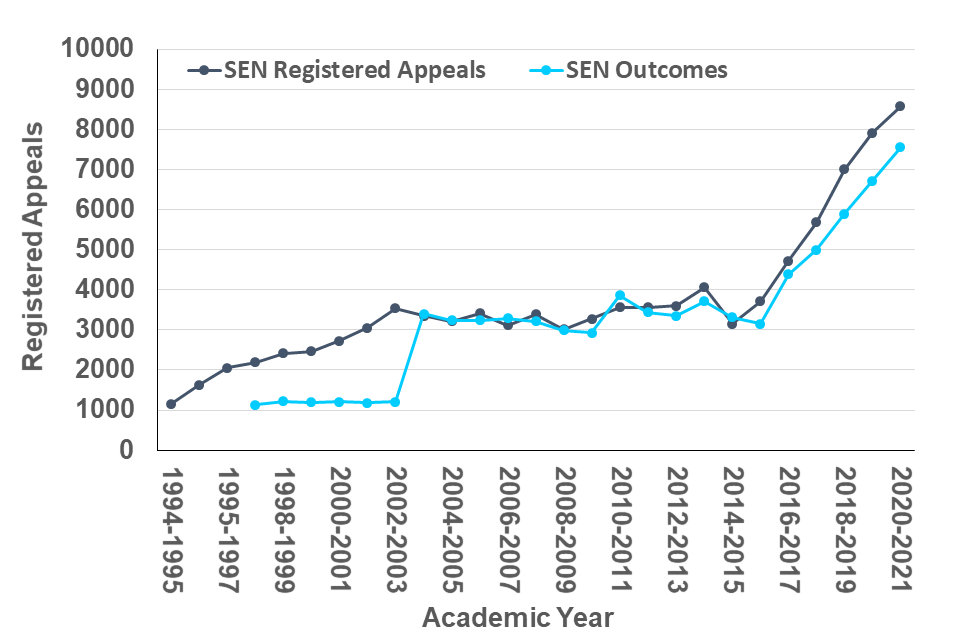
SEND reforms, which came into effect from 1 September 2014, introduced Education Health and Care (EHC) plans and extended provision of support from birth to 25 years of age for those in education (excluding Higher education).
Of the 8,600 registered SEN appeals in 2020/21, 27% were against ‘refusal to secure an EHC assessment’, while over half (59%) were in relation to the content of EHC plans. The most common type of educational need identified in appeals continues to be Autistic Spectrum Disorder, accounting for 47% (4,000) of all SEN appeals.
SEND caseload outstanding reached a new high of 3,900 cases in Q2 2021/22, driven by the previously noted rising trend in SEND appeals registered.
Figure 7.2: SEND Caseload Outstanding, Q2 2009/10 to Q2 2021/22 (Source: Table S_4)[footnote 4]
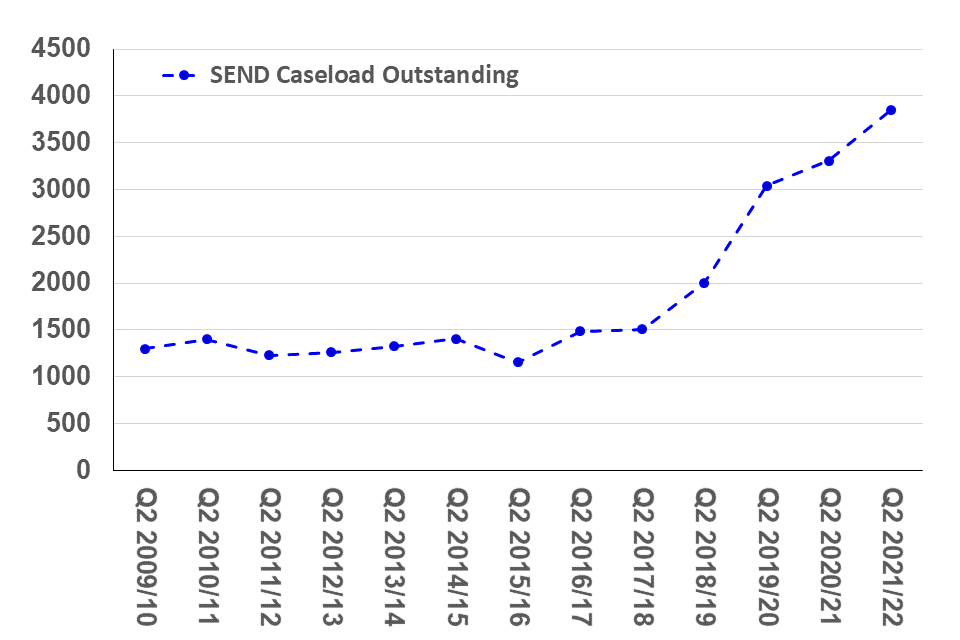
In 2020/21, ethnicity data was ‘not completed’ for any of the appeals registered, therefore it is not possible to provide analysis of SEN appeals by child ethnicity. As the table on ethnic origin (previously SEND_4) provides no new information, it has been removed from this publication. We will monitor the data regularly and reintroduce this table when the data is populated.
In 2020/21, HMCTS recorded 7,600 outcomes in relation to SEN appeals, an increase of 12% compared to 2019/20. Of these outcomes, 64% (4,800) of cases were decided by the tribunal, an increase of 8 percentage points on 2019/20. Of the cases decided, 96% (4,700) were in favour of the appellant, an increase of two percentage points on 2019/20.
In 2020/21, there were 170 registered appeals in relation to disability discrimination, eight less than the previous year (5% fall). Of these appeals, eight cases (5%) were related to permanent exclusion from school and the remainder were uncategorised.
The SEND tribunals disposed of 110 Disability Discrimination claims in 2020/21, down from 140 in the previous year (20% fall). Of these disposals, 61 claims (56%) were decided at hearing, 48 appeals (44%) were withdrawn prior to the hearing taking place, and no appeals were conceded. Of those decided at hearing, 41% were dismissed and 59% upheld – compared to 53% dismissed and 47% upheld in 2019/20.
8. Other Tribunals
Increase in First-tier tax Chamber receipts by 314% compared to the same quarter last year
The First-tier Tax Chamber recorded 6,400 receipts this quarter, an increase of 314% compared to the same quarter last year. In the same period, 1,400 appeals were disposed of and caseload outstanding increased by 9% (to 29,600).
Mental Health receipts, disposals and caseload outstanding all decreased compared to both 2020/21 and 2019/20
Mental health receipts, disposals and caseload outstanding have all decreased when compared to July to September 2020, by 6%, 7% and 5% respectively.
First-tier Tax Chamber
There has been an increase in all case types in the First-tier Tax Chamber this quarter. Receipts increased by 314%, to 6,400, compared to the same quarter last year. This is the highest number of receipts seen in any one quarter since 2009. Disposals and caseload outstanding also increased by 33% and 9% to 1,400 and 29,600 respectively. This trend is likely to continue as Treasury and HMRC increase action against umbrella companies employing potentially fraudulent VAT schemes.
Mental Health
Mental health figures have remained stable this quarter. Receipts decreased by 6% in July to September 2021 (8,000), compared to the same period in 2020, and in 2019/20, which was pre-COVID, the volume decreased by 8%. The tribunal disposed of 8,200 appeals in Q2 2021/22, a decrease of 7% and 6% when compared to Q2 2020/21 and Q2 2019/20 respectively. There were 3,700 Mental Health cases outstanding at the end of September 2021, down 5% compared to the same period in 2020.
The mean age of cases at clearance for the Mental Health section 2, Mental Health Restricted Patients, and the Mental Health Non Restricted Patients case types has remained consistent for the same period in the last couple of years at 1, 12 and 6 weeks respectively.
9. Further information
Rounding convention
Figures greater than 10,000 are rounded to the nearest 1,000, those between 1,000 and 10,000 are rounded to the nearest 100 and those between 100 to 1,000 are rounded to the nearest 10. Less than 100 are given as the actual number.
Accompanying files
As well as this bulletin, the following products are published as part of this release:
-
A supporting document providing further information on how the data is collected and processed, as well as information on the revisions policy and legislation relevant to trends and background on the functioning of the tribunal system.
-
The quality statement published with this guide sets out our policies for producing quality statistical outputs for the information we provide to maintain our users’ understanding and trust.
-
A set of overview tables, covering each section of this bulletin, an annual set of tables covering further breakdown of Special Educational Needs and Disability statistics for the Academic Year 2020/21.
-
A set of CSV files including data on two of the three large tribunals (SSCS and Immigration and Asylum) and an overall receipts and disposals CSV, covering all tribunal types.
-
Additional releases this quarter:
- Update to the statistical notice on Immigration and Asylum (I&A) Detained Immigration Appeals (DIA) to include data to Q2 2021/22.
Future publications
Our statisticians regularly review the content of publications. Development of new and improved statistical outputs is usually dependent on reallocating existing resources. As part of our continual review and prioritisation, we welcome user feedback on existing outputs including content, breadth, frequency and methodology. Please send any comments you have on this publication including suggestions for further developments or reductions in content.
Contact
Press enquiries should be directed to the Ministry of Justice or HMCTS press office:
Daniel Mulloy - email: Daniel.Mulloy@Justice.gov.uk
Other enquiries and feedback on these statistics should be directed to the Data and Evidence as a Service division of the Ministry of Justice:
Rita Kumi-Ampofo or Tess Williams - email: CAJS@justice.gov.uk
Next update: 10 March 2022 (URL: www.gov.uk/government/collections/tribunals-statistics)
© Crown copyright Produced by the Ministry of Justice
For any feedback on the layout or content of this publication or requests for alternative formats, please contact CAJS@justice.gov.uk
-
The interim totals for the overall volumes of tribunal receipts, disposals and caseload outstanding exclude the Upper Tribunal (Immigration and Asylum Chamber), Employment Tribunal and Employment Appeal Tribunal for which the data is currently not available. See the main tables S_2, S_3 and S_4 for more information. ↩ ↩2 ↩3 ↩4 ↩5 ↩6 ↩7 ↩8 ↩9 ↩10 ↩11
-
Outstanding caseload is based on a snapshot in time based on the last day of each quarter. ↩
-
Official statistics overview: Universal Credit statistics, 29 April 2013 to 14 October 2021 - GOV.UK (www.gov.uk) ↩
-
The underlying data for Figure 7.1 is the Special Educational Needs (SEN) appeals and outcomes for each academic year (1st September to 31st August) which can be found in SEND_1. The underlying data in Figure 7.2 for the caseload outstanding trendline is from the Special Educational Needs and Disability (SEND) caseload outstanding as at Q2 of each year which can be found in S_4 of the main tables. ↩ ↩2
